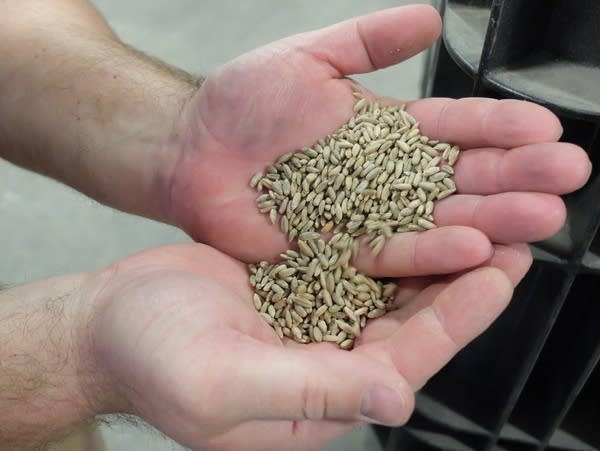Inside the whiskey revolution in northern Minnesota

Go Deeper.
Create an account or log in to save stories.
Like this?
Thanks for liking this story! We have added it to a list of your favorite stories.
Mike Swanson thinks Minnesota could be at the center of a whiskey revolution.
And he is accumulating the data to prove it.
Whiskey aficionados pay a lot of attention to the aging process when they look for high-quality whiskey.
Swanson, who owns Hallock, Minn.-based Far North Spirits, argues craft distillers need to pay more attention to the front end of the process. In the case of whiskey, it's the rye that makes the mash that makes the whiskey.
Turn Up Your Support
MPR News helps you turn down the noise and build shared understanding. Turn up your support for this public resource and keep trusted journalism accessible to all.
Swanson concedes that Far North and other small distilleries can't beat Makers Mark at their own game. "But we can out farm them. Because they're being supplied by grain merchants and they don't know what variety they're distilling."

He was curious whether each rye variety would add different flavors to whiskey, so he got a grant from the Minnesota Department of Agriculture to study rye varieties for taste.
Swanson is now distilling 18 varieties of rye. The crop is planted in the fall and harvested late the following summer.
"To our knowledge, this has never been done before," Swanson said of the taste research. "If it has, it's somebody's proprietary company information. One of the big distilling houses might have done this, but they didn't publish it. We're the first to go public with this sort of thing."
It will be a couple of years before the study is published, but the results are promising.
With a large copper still roaring in the background, Swanson pours clear distillate, called white whiskey or moonshine, into three glasses lined up on a table.

"Three different samples of distillate, three different varieties," said Swanson, closing his eyes and inhaling the fumes from each glass. "The differences start when you put your nose up to the glass."
As he swirls and sniffs, Swanson talks about vanilla, spice and grassiness.
It's hard to scientifically measure taste and smell. This study is based on large-scale taste and smell testing by hundreds of accomplished distillers and whiskey experts who do blind tests and offer their observations on each variety. With hundreds of tests, Swanson sees patterns emerge. One rye has consistently strong vanilla notes, another commonly reminds people of tequilla.
Once the distinctive characteristics of each rye variety are established, Swanson's dream is to link distillers and farmers who will grow specific varieties for a premium price.
"Depending on the flavor profile that a distiller is going for, they can select a variety that is reliably going to produce that flavor," said Swanson.
He hopes this research will lead to a distinctive Minnesota taste that will excite whiskey lovers everywhere.
But the study is about more than tasty whiskey.

Rye will need to attract more than a few farmers to be a viable alternative crop.
"The bottom line is always going to be is it economically viable against other commodities, because that's how you get acres," said Jochum Wiersma, an agronomist at the University of Minnesota, Crookston.
He's studying yield potential and disease resistance in the same rye varieties that Swanson is testing for taste. Wiersma thinks rye has potential as animal feed and as a cover crop, grown to prevent soil erosion and keep fertilizer from polluting streams.
And rye can be very productive in Minnesota.
"It is by far the most winter-hardy and has a really good fit, in especially really sandy soil," Wiersma said. "It is probably the most drought tolerant of any crops that can be used for both feed and food."

Rye is much more popular in Europe where rye flour is commonly used in breads. It's also more widely used in animal feed. Wiersma said research is starting to show that animals fed a mix that includes rye have healthier gut bacteria and are less likely to need antibiotics.
Historically, rye has been susceptible to a fungal disease that creates a toxin on the grain harmful to animals and humans. That's still a concern, but Wiersma said newer varieties are much more resistant, and new techniques have been developed to clean the grain.
Some of the best rye varieties for the Minnesota climate were developed in northern Europe, and Wiersma said companies there are interested in expanding rye production in the U.S.

A researcher from North Dakota State University is also involved in the research, studying the malting process for rye. Malting is a process of sprouting and toasting the grain. Malted barley is commonly used in beer and malt is also used in some whiskey varieties.
Rye is an almost invisible blip on a Minnesota landscape dominated by corn and soybeans — only a few thousand acres are grown, compared to millions of acres of the dominant crops.
Swanson admits small distillers won't bring about a big resurgence of rye, since just a few acres will grow enough to make a batch of craft whiskey.
"It'll be a niche crop, but a profitable one. Because distillers are usually willing to pay more for a premium raw material," said Swanson, who's thinking big about the future of whiskey in Minnesota.
"In Scotland, you have all these different styles of whiskey that are very, very different from each other. I would love to see the same thing here. And I think rye is still up for grabs."



